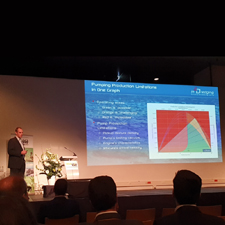This year’s Central Dredging Association’s (CEDA) flagship conference and exhibition was held in Rotterdam, in conjunction with the Europort Exhibition. in2Dredging (i2D) was one of the presenters at the conference, delivering a well‑received presentation on production estimates and performance monitoring.
Topics Discussed at CEDA Dredging Days
A main point of focus at the conference this year was the transition to clean energy and how to make operations more efficient. One of the methods discussed to achieve this was controlling emissions. Therefore, different propulsion methods for dredges and auxiliary equipment were discussed as a means of controlling emissions, such as energy storage systems.
Another method discussed for achieving operational efficiencies was introducing efficiency measures, such as performance monitoring, in the dredging process itself. These measures were covered in a presentation by Simon Burgmans, Director and Principal Consultant at i2D. As mentioned in a news article on Dredging and Port Construction’s website, Simon “reminded the audience how important, and readily available performance monitoring is. ‘Any dredge with a digital system can acquire data and make this data available for performance reviewing purposes.’”
Production Estimates are Key to Budgets and Schedules
The main message of i2D’s presentation was that accurate production estimates are key in determining dredging projects’ budgets and schedules.
As many physical conditions can significantly affect production levels, the presentation pointed out that it is essential to simulate:
- each project stage and work methodology;
- all soil properties and conditions;
- detailed equipment configurations; and
- known likely delays.
Any physical condition overlooked in an estimate invariably leads to shortfalls in both the project’s overall budget and schedule. At best, such projects typically result in minimal profits, and at worst in losses, claims, court cases or even insolvency.
As no contract can provide complete protection from a contractor underperforming, a robust production estimate is key to the success of any dredging project. To ensure a contractor’s production estimate is robust, Simon advised that clients should conduct their own shadow production estimates. These should be conducted with or without a consultant’s help, as early as possible, preferably in the tender evaluation phase, but definitely before committing or mobilising. To this end, clients need to acquire enough information, right from the conceptual phase, which will allow them to simulate the above bulleted points.
Simon’s presentation aimed to help clients to recognise optimistic or unrealistic budgets and schedules. He presented case studies to help demonstrate how physical and operational conditions can easily be overlooked and discussed issues that may arise from such oversights. Furthermore, the presentation provided details of a systematic high‑level approach that makes it possible for any user to gather enough information to accurately estimate their own production levels.
Conclusion
Simon advised that high-definition production estimates always reduce operational and contractual risk due to schedule delays and cost overruns. These detailed estimates should be based on both experience and theory and, should be produced by both Clients and Contractors. He also informed the audience that, advanced tools for pumping, cutting and jetting are commercially available to help produce the required high‑definition, robust and reliable estimates. These in turn inform budget and schedules that ensure the successful outcome of a dredging project.

